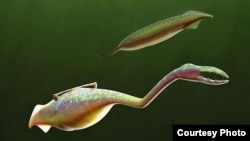It is one of the strangest looking fossils ever discovered. So strange that scientists dubbed it the Tully Monster, after Francis Tully, the amateur fossil hunter who discovered it in 1958 in the central United States.
Now a group of researchers from Yale University may have finally answered some questions about this evolutionary oddity, officially known as Tullimonstrum gregarium.
Their results are published in today’s issue of the journal Nature and offer the clearest picture yet as to what this 300-million-year-old sea creature was all about.
"I was first intrigued by the mystery of the Tully Monster. With all of the exceptional fossils, we had a very clear picture of what it looked like, but no clear picture of what it was," said lead author Victoria McCoy.
An Ocean Dwelling Nightmare
The creature certainly looked like a monster: its teeth and mouth were placed at the end of a long trunk-like neck that looked more like a claw than a mouth.
And even stranger, its eyes were placed just above its midsection on either side of its body at the end of what looks like a curtain rod laid across its back. It only grew to a third of a meter.
But while they may have looked strange, they were prolific; scientists have recovered thousands of Tully Monster fossils.
For years, scientists have been puzzled not only by its appearance, but by where this unusual swimmer actually belonged in terms of lineage - was it a mollusk, or a fish, or something else entirely?
"Basically, nobody knew what it was," said co-author Derek Briggs, from Yale. "The fossils are not easy to interpret, and they vary quite a bit. Some people thought it might be this bizarre, swimming mollusk. We decided to throw every possible analytical technique at it."
A High-Tech Look at an Ancient Creature
And that’s what they did. The team looked closely at the fossil specimens they had, analyzing the way the animal was shaped and how its odd features worked.
They also used some high-tech techniques like synchrotron elemental mapping, which uses x-rays to light up various parts of a fossil’s anatomy.
And what they concluded that the Tully Monster, while monstrous, had gills and a rudimentary spinal cord called a notochord, two things scientists didn’t know until now.
They also discovered that it was likely a predator - no big surprise, given its jaw full of teeth - and that its closest living relative is the modern lamprey.
But some questions remain as to when it arrived on the scene, and when it became extinct. Another mystery is why Tully Monster fossils have only been found in a single area, in what is now a coal mine in Illinois.






